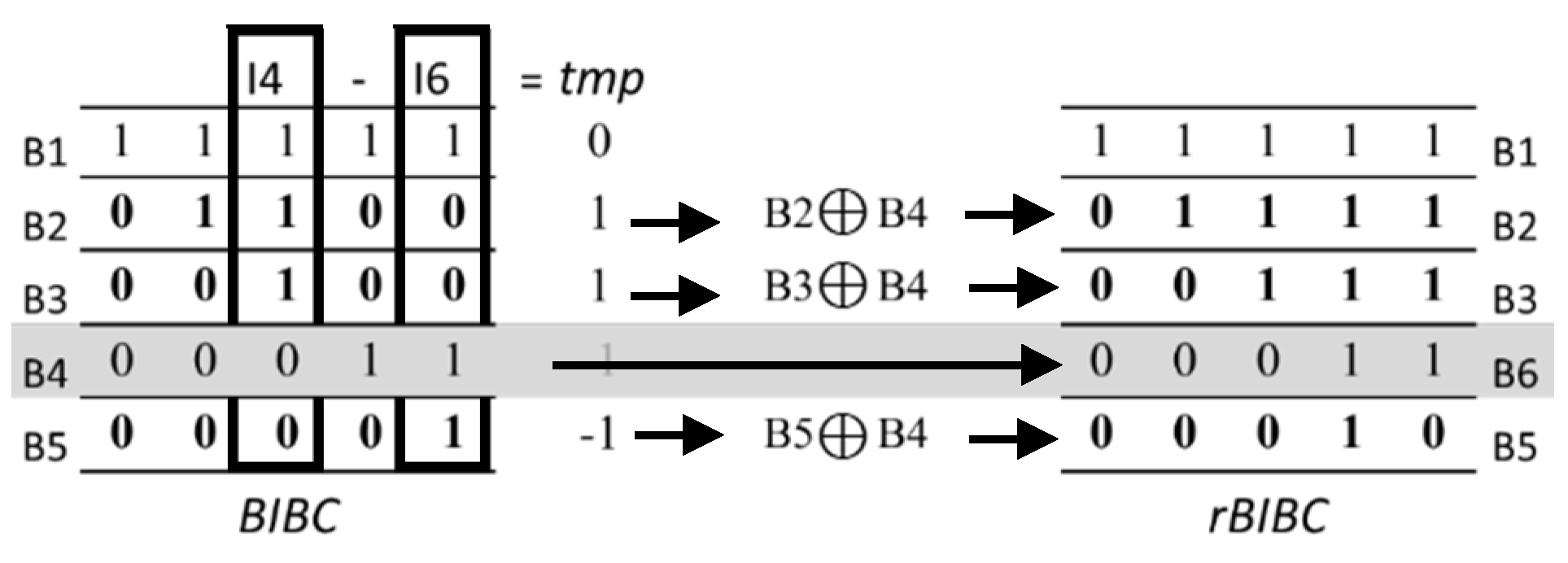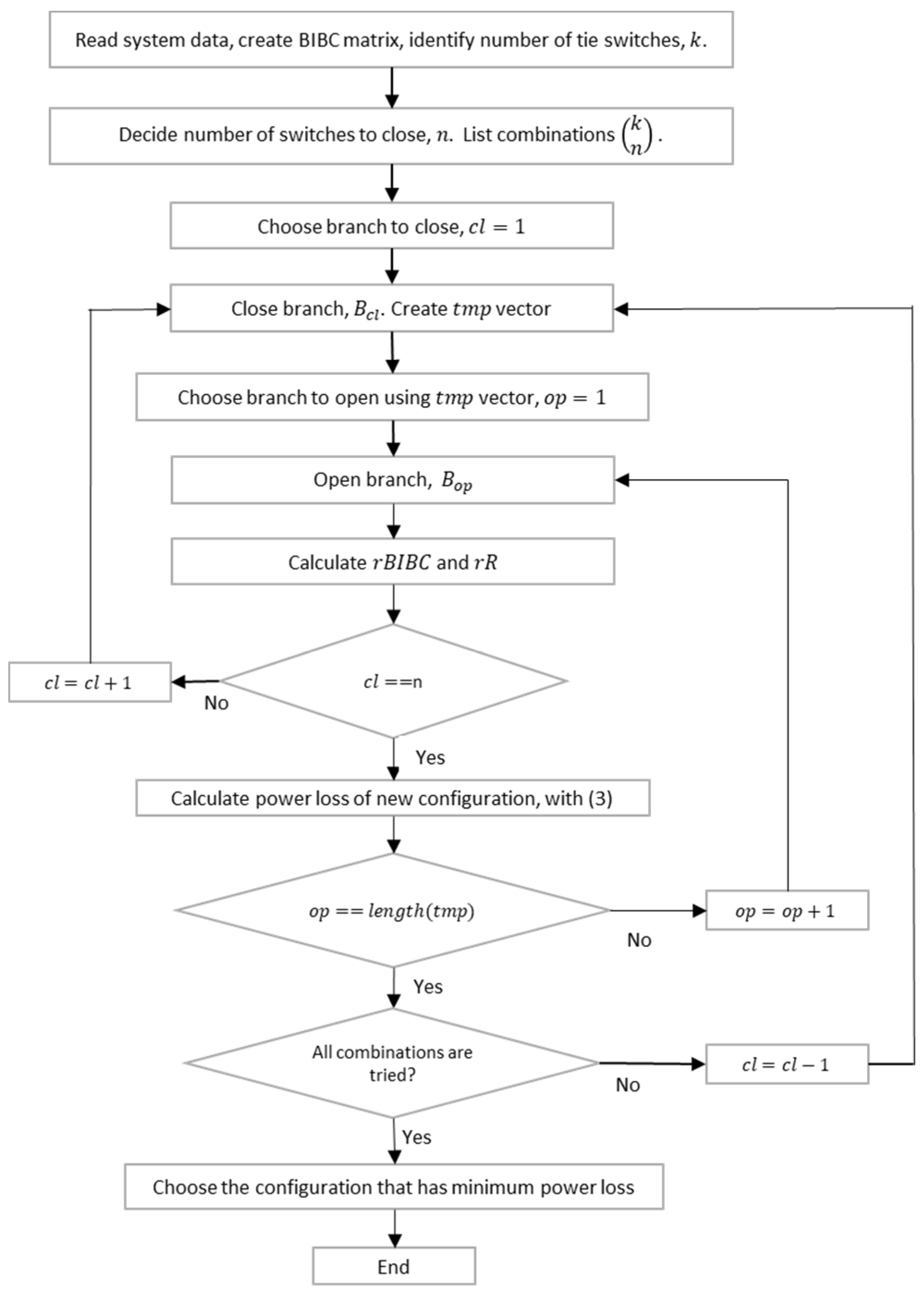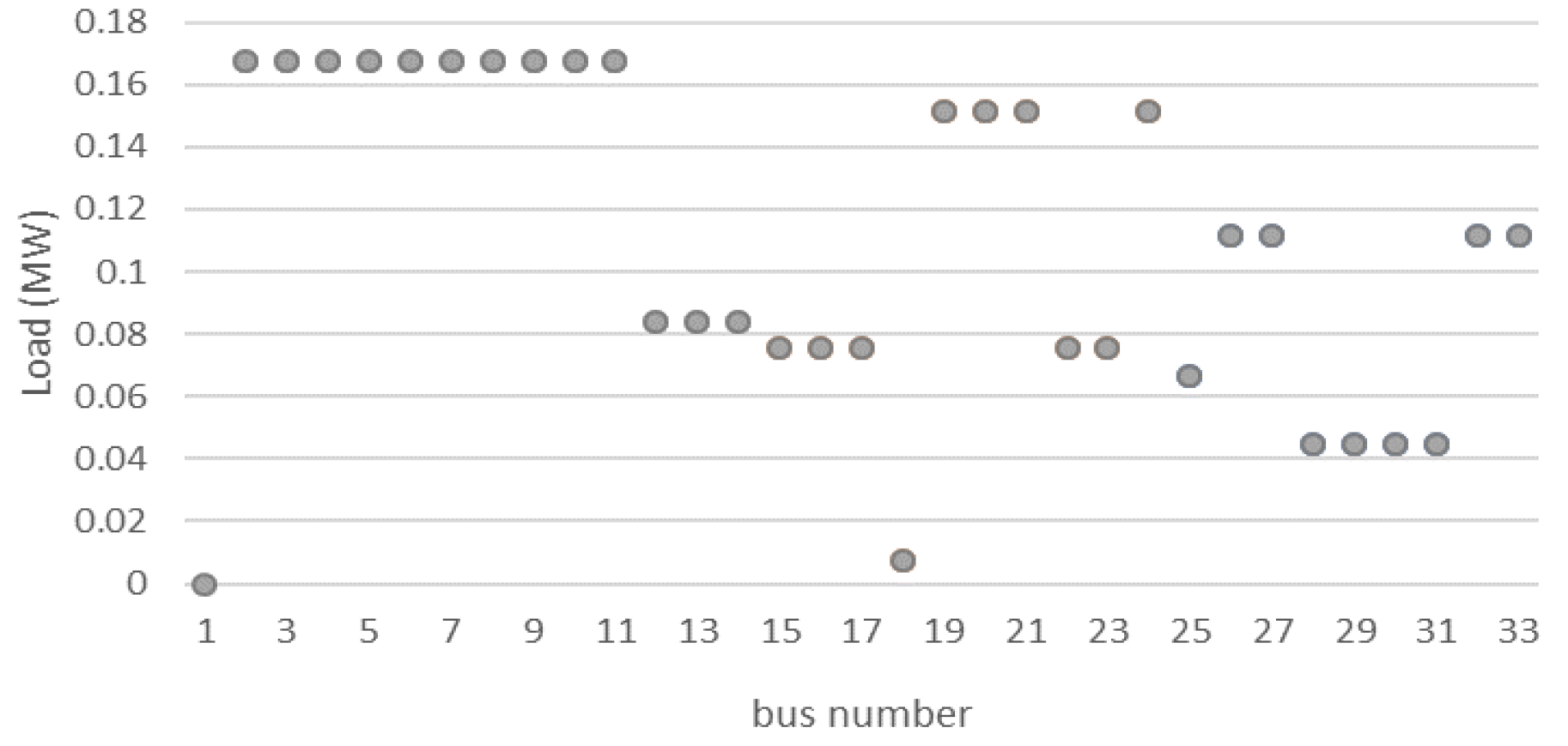BIBC Matrix Modification for Network Topology Changes: Reconfiguration Problem Implementation
Abstract
:1. Introduction
2. Analytical Power Loss Calculation for Distribution Networks
3. BIBC Matrix Modification for Topology Change Representation
| Algorithm |
|
4. Problem Definition and Grid Search Algorithm for Reconfiguration
| Algorithm |
|
5. Distribution Network Load Modelling
5.1. Static Load Model
5.2. Time Varying Load Model
6. Analysis and Results
6.1. Reconfiguration for 33-Bus System
6.2. Reconfiguration for 69-Bus System
6.3. Reconfiguration for Networks with Time Varying Loads
7. Discussion
8. Conclusions
Author Contributions
Funding
Conflicts of Interest
References
- Di Fazio, A.R.; Russo, M.; Valeri, S.; de Santis, M. Linear method for steady-state analysis of radial distribution systems. Int. J. Electr. Power Energy Syst. 2018, 99, 744–755. [Google Scholar] [CrossRef]
- Teng, J.H. A direct approach for distribution system load flow solutions. IEEE Trans. Power Deliv. 2003, 18, 882–887. [Google Scholar] [CrossRef]
- Garces, A. A Linear Three-Phase Load Flow for Power Distribution Systems. IEEE Trans. Power Syst. 2016, 31, 827–828. [Google Scholar] [CrossRef]
- Wang, Y.; Zhang, N.; Li, H.; Yang, J.; Kang, C. Linear three-phase power flow for unbalanced active distribution networks with PV nodes. CSEE J. Power Energy Syst. 2017, 3, 321–324. [Google Scholar] [CrossRef]
- Ayres, H.M.; Salles, D.; Freitas, W. A practical second-order based method for power losses estimation in distribution systems with distributed generation. IEEE Trans. Power Syst. 2014, 29, 666–674. [Google Scholar] [CrossRef]
- Gözel, T.; Hocaoglu, M.H. An analytical method for the sizing and siting of distributed generators in radial systems. Electr. Power Syst. Res. 2009, 9, 912–918. [Google Scholar] [CrossRef]
- Ahmadi, H.; Martí, J.R. Distribution system optimization based on a linear power-flow formulation. IEEE Trans. Power Deliv. 2015, 30, 25–33. [Google Scholar] [CrossRef]
- Oshnoei, A.; Khezri, R.; Hagh, M.T.; Techato, K.; Muyeen, S.M.; Sadeghian, O. Direct probabilistic load flow in radial distribution systems including wind farms: An approach based on data clustering. Energies 2018, 11, 310. [Google Scholar] [CrossRef] [Green Version]
- Eminoglu, U.; Gözel, T.; Hocaoglu, M.H. DSPFAP: Distribution systems power flow analysis package using matlab graphical user interface (GUI). Comput. Appl. Eng. Educ. 2010, 18, 1–13. [Google Scholar] [CrossRef]
- Parihar, S.S.; Malik, N. Power flow analysis of balanced radial distribution system with composite load model. In Proceedings of the 2017 Recent Developments in Control, Automation and Power Engineering, RDCAPE 2017, Noida, India, 26–27 October 2017. [Google Scholar]
- Teng, J.H. Integration of distributed generators into distribution three-phase load flow analysis. In Proceedings of the 2005 IEEE Russia Power Tech, PowerTech, St. Petersburg, Russia, 27–30 June 2005. [Google Scholar]
- Bazrafshan, M.; Gatsis, N. Comprehensive Modeling of Three-Phase Distribution Systems via the Bus Admittance Matrix. IEEE Trans. Power Syst. 2018, 33, 2015–2029. [Google Scholar] [CrossRef] [Green Version]
- Memon, Z.A.; Trinchero, R.; Xie, Y.; Canavero, F.G.; Stievano, I.S. An Iterative Scheme for the Power-Flow Analysis of Distribution Networks based on Decoupled Circuit Equivalents in the Phasor Domain. Energies 2020, 13, 386. [Google Scholar] [CrossRef] [Green Version]
- Cetindag, B.; Kocar, I.; Gueye, A.; Karaagac, U. Modeling of Step Voltage Regulators in Multiphase Load Flow Solution of Distribution Systems Using Newton’s Method and Augmented Nodal Analysis. Electr. Power Components Syst. 2017, 45, 1667–1677. [Google Scholar] [CrossRef]
- Teng, J.H.; Lu, C.N. Feeder-switch relocation for customer interruption cost minimization. IEEE Trans. Power Deliv. 2002, 17, 254–259. [Google Scholar] [CrossRef]
- Baran, M.E.; Wu, F.F. Network reconfiguration in distribution systems for loss reduction and load balancing. IEEE Trans. Power Deliv. 1989, 17, 254–259. [Google Scholar]
- Shi, Q.; Li, F.; Olama, M.; Dong, J.; Xue, Y.; Starke, M.; Winstead, C.; Kuruganti, T. Network reconfiguration and distributed energy resource scheduling for improved distribution system resilience. Int. J. Electr. Power Energy Syst. 2021, 124, 106355. [Google Scholar] [CrossRef]
- Raoufi, H.; Vahidinasab, V.; Mehran, K. Power systems resilience metrics: A comprehensive review of challenges and outlook. Sustainability 2020, 12, 9698. [Google Scholar] [CrossRef]
- Sambaiah, K.S.; Jayabarathi, T. Loss minimization techniques for optimal operation and planning of distribution systems: A review of different methodologies. Int. Trans. Electr. Energy Syst. 2019, 30. [Google Scholar] [CrossRef] [Green Version]
- Shirmohammadi, D.; Hong, H.W. Reconfiguration of electric distribution networks for resistive line losses reduction. IEEE Trans. Power Deliv. 1989, 4, 1492–1498. [Google Scholar] [CrossRef]
- Civanlar, S.; Grainger, J.J.; Yin, H.; Lee, S.S.H. Distribution Feeder Reconfiguration for Loss Reduction. IEEE Trans. Power Deliv. 1988, 3, 1217–1223. [Google Scholar] [CrossRef]
- Goswami, S.K.; Basu, S.K. A new algorithm for the reconfiguration of distribution feeders for loss minimization. IEEE Trans. Power Deliv. 1992, 7, 1484–1491. [Google Scholar] [CrossRef]
- Nara, K.; Shiose, A.; Kitagawa, M.; Ishihara, T. Implementation of Genetic Algorithm for Distribution Systems Loss Minimum Re-Configuration. IEEE Trans. Power Syst. 1992, 7, 1044–1051. [Google Scholar] [CrossRef]
- Su, C.T.; Chang, C.F.; Chiou, J.P. Distribution network reconfiguration for loss reduction by ant colony search algorithm. Electr. Power Syst. Res. 2005, 75, 190–199. [Google Scholar] [CrossRef]
- Rao, R.S.; Narasimham, S.V.L.; Raju, M.R.; Rao, A.S. Optimal network reconfiguration of large-scale distribution system using harmony search algorithm. IEEE Trans. Power Syst. 2011, 26, 1080–1088. [Google Scholar]
- Abdelaziz, A.Y.; Mohammed, F.M.; Mekhamer, S.F.; Badr, M.A.L. Distribution Systems Reconfiguration using a modified particle swarm optimization algorithm. Electr. Power Syst. Res. 2009, 79, 1521–1530. [Google Scholar] [CrossRef]
- Kumar, K.S.; Jayabarathi, T. Power system reconfiguration and loss minimization for an distribution systems using bacterial foraging optimization algorithm. Int. J. Electr. Power Energy Syst. 2012, 36, 13–17. [Google Scholar] [CrossRef]
- Imran, A.M.; Kowsalya, M. A new power system reconfiguration scheme for power loss minimization and voltage profile enhancement using Fireworks Algorithm. Int. J. Electr. Power Energy Syst. 2014, 62, 312–322. [Google Scholar] [CrossRef]
- Nguyen, T.T.; Nguyen, T.T. An improved cuckoo search algorithm for the problem of electric distribution network reconfiguration. Appl. Soft Comput. J. 2019, 84, 105720. [Google Scholar] [CrossRef]
- Gerez, C.; Silva, L.I.; Belati, E.A.; Filho, A.J.S.; Costa, E.C.M. Distribution Network Reconfiguration Using Selective Firefly Algorithm and a Load Flow Analysis Criterion for Reducing the Search Space. IEEE Access 2019, 7, 67874–67888. [Google Scholar] [CrossRef]
- Onlam, A.; Yodphet, D.; Chatthaworn, R.; Surawanitkun, C.; Siritaratiwat, A.; Khunkitti, P. Power loss minimization and voltage stability improvement in electrical distribution system via network reconfiguration and distributed generation placement using novel adaptive shuffled frogs leaping algorithm. Energies 2019, 12, 553. [Google Scholar] [CrossRef] [Green Version]
- El-salam, M.A.; Beshr, E.; Eteiba, M. A New Hybrid Technique for Minimizing Power Losses in a Distribution System by Optimal Sizing and Siting of Distributed Generators with Network Reconfiguration. Energies 2018, 11, 3351. [Google Scholar] [CrossRef] [Green Version]
- Tran, T.T.; Truong, K.H.; Vo, D.N. Stochastic fractal search algorithm for reconfiguration of distribution networks with distributed generations. Ain Shams Eng. J. 2020, 11, 389–407. [Google Scholar] [CrossRef]
- Milani, A.E.; Haghifam, M.R. An evolutionary approach for optimal time interval determination in distribution network reconfiguration under variable load. Math. Comput. Model 2013, 57, 68–77. [Google Scholar] [CrossRef]
- Chidanandappa, R.; Ananthapadmanabha, T.; Ranjith, H.C. Genetic Algorithm Based Network Reconfiguration in Distribution Systems with Multiple DGs for Time Varying Loads. Procedia Technol. 2015, 21, 460–467. [Google Scholar] [CrossRef] [Green Version]
- Zhan, J.; Liu, W.; Chung, C.Y.; Yang, J. Switch Opening and Exchange Method for Stochastic Distribution Network Reconfiguration. IEEE Trans. Smart Grid 2020, 11, 2995–3007. [Google Scholar] [CrossRef]
- Teimourzadeh, H.; Mohammadi-Ivatloo, B. A three-dimensional group search optimization approach for simultaneous planning of distributed generation units and distribution network reconfiguration. Appl. Soft Comput. 2020, 88, 106012. [Google Scholar] [CrossRef]
- Xing, H.; Sun, X. Distributed generation locating and sizing in active distribution network considering network reconfiguration. IEEE Access 2017, 5, 14768–14774. [Google Scholar] [CrossRef]
- Amin, A.; Tareen, W.U.K.; Usman, M.; Memon, K.A.; Horan, B.; Mahmood, A.; Mekhilef, S. An integrated approach to optimal charging scheduling of electric vehicles integrated with improved medium-voltage network reconfiguration for power loss minimization. Sustainability 2020, 12, 9211. [Google Scholar] [CrossRef]
- Chen, Q.; Wang, W.; Wang, H.; Wu, J.; Li, X.; Lan, J. A Social Beetle Swarm Algorithm Based on Grey Target Decision-Making for a Multiobjective Distribution Network Reconfiguration Considering Partition of Time Intervals. IEEE Access 2020, 8, 204987–205013. [Google Scholar] [CrossRef]
- Teimourzadeh, S.; Zare, K. Application of binary group search optimization to distribution network reconfiguration. Int. J. Electr. Power Energy Syst. 2014, 62, 461–468. [Google Scholar] [CrossRef]
- Thukaram, D.; Banda, H.M.W.; Jerome, J. Robust three phase power flow algorithm for radial distribution systems. Electr. Power Syst. Res. 1999, 50, 227–236. [Google Scholar] [CrossRef]
- Iliceto, F.; Ceyhan, A.; Ruckstuhl, G. Behavior of loads during voltage dips encountered in stability studies. Field and laboratory tests. IEEE Trans. Power Appar. Syst. 1972, PAS-91, 2470–2479. [Google Scholar]
- Vaahedi, E.; Fl-Kady, M.A.; Libaque-Esaine, J.A.; Carvelho, V.F. Load Models for Large-Scale Stability Studies from End-User Consumption. IEEE Trans. Power Syst. 1987, 2, 864–870. [Google Scholar] [CrossRef]
- Baran, M.E.; Wu, F.F. Optimal capacitor placement on radial distribution systems. IEEE Trans. Power Deliv. 1989, 4, 725–734. [Google Scholar] [CrossRef]
- Ramos, E.R.; Expósito, A.G.; Santos, J.R.; Iborra, F.L. Path-based distribution network modeling: Application to reconfiguration for loss reduction. IEEE Trans. Power Syst. 2005, 20, 556–564. [Google Scholar] [CrossRef]
- McDermott, T.E.; Drezga, I.; Broadwater, R.P. A heuristic nonlinear constructive method for distribution system reconfiguration. IEEE Trans. Power Syst. 1999, 14, 478–483. [Google Scholar] [CrossRef]
- Mishra, S.; Paul, S.; Das, D. A comprehensive review on power distribution network reconfiguration. Energy Syst. 2016, 8, 227–284. [Google Scholar] [CrossRef]
- The, T.T.; Ngoc, D.V.; Anh, N.T. Distribution Network Reconfiguration for Power Loss Reduction and Voltage Profile Improvement Using Chaotic Stochastic Fractal Search Algorithm. Complexity 2020, 2020, 1–15. [Google Scholar]







| Load Type | Summer/Day | Summer/Night | Winter/Day | Winter/Night | ||||
|---|---|---|---|---|---|---|---|---|
| np | nq | np | nq | np | nq | np | nq | |
| Residential | 0.72 | 2.96 | 0.92 | 4.04 | 1.04 | 4.19 | 1.30 | 4.38 |
| Commercial | 1.25 | 3.50 | 0.99 | 3.95 | 1.50 | 3.15 | 1.51 | 3.40 |
| Industrial | 0.18 | 6.00 | 0.18 | 6.00 | 0.18 | 6.00 | 0.18 | 6.00 |
| GS-1 | ||||
| Load model | Final configuration | Power loss before reconfiguration (kW) | Power loss after reconfiguration (kW) | CPU time (s) |
| constant current | 7-9-14-32-37 | 176.37 | 127.36 | 19 |
| GS-2 | ||||
| Load exponents | Final configuration | Power loss before reconfiguration (kW) | Power loss after reconfiguration (kW) | CPU time (s) |
| np = nq = 0 constant power | 7-9-14-28-32 | 202.676 | 135.385 | ~170 |
| np = nq = 0.5 | 7-9-14-28-32 | 188.676 | 131.474 | |
| np = nq = 1 constant current | 7-9-14-32-37 | 176.628 | 127.371 | |
| np = nq = 1.5 | 7-9-14-32-37 | 166.124 | 122.556 | |
| np = nq = 2 | 7-9-14-32-37 | 156.872 | 118.121 | |
| np = nq = 2.5 | 7-9-14-32-37 | 148.649 | 114.021 | |
| np = nq = 3 | 7-9-14-32-37 | 141.279 | 110.216 | |
| np = nq = 3.5 | 7-9-14-32-37 | 134.634 | 106.676 | |
| np = nq = 4 | 7-9-14-31-37 | 128.611 | 103.201 | |
| np = nq = 4.5 | 7-9-14-31-37 | 123.118 | 99.917 | |
| np = nq = 5 | 7-9-14-31-37 | 118.087 | 96.856 | |
| GS-1 | ||||
| Load model | Final configuration | Power loss before reconfiguration (kW) | Power loss after reconfiguration (kW) | CPU time (s) |
| constant current | 14-55-61-69-70 | 191.50 | 90.79 | 216 |
| GS-2 | ||||
| Load exponents | Final configuration | Power loss before reconfiguration (kW) | Power loss after reconfiguration (kW) | CPU time (s) |
| np = nq = 0 constant power | 14-58-61-69-70 | 224.99 | 93.44 | 3341 |
| np = nq = 1 constant current | 14-58-61-69-70 | 191.50 | 90.79 | 3429 |
| np = 0.72 nq = 2.96 residential | 13-55-61-69-70 | 181.01 | 89.39 | 3580 |
| np = 1.25 nq = 3.50 commercial | 13-55-61-69-70 | 168.46 | 87.69 | 3660 |
| np = 0.18 nq = 6.00 industrial | 13-55-61-69-70 | 175.09 | 87.74 | 3700 |
| GS-1 | ||||||
| Load type | Final configuration | Power loss before reconfiguration (kW) | Power loss after reconfiguration (kW) | CPU time (s) | ||
| residential | 9-14-16-27-33 | 1438.40 | 875.01 | 588.1 | ||
| commercial | 9-14-16-27-33 | 1400.10 | 851.73 | 590.6 | ||
| industrial | 9-14-16-27-33 | 1720.50 | 1046.60 | 585.1 | ||
| GS-2 | ||||||
| Load type | Season | Load exponent | Final configuration | Power loss before reconfiguration (kW) | Power loss after reconfiguration (kW) | CPU time (s) |
| residential | summer/day | np = 0.72 nq = 2.96 | 9-14-16-27-33 | 1453.40 | 877.75 | 3732.7 |
| summer/night | np = 0.92 nq = 4.04 | |||||
| winter/day | np = 1.04 nq = 4.19 | 9-14-16-27-33 | 1422.30 | 870.48 | 3726.2 | |
| winter/night | np = 1.30 nq = 4.38 | |||||
| commercial | summer/day | np = 0.72 nq = 2.96 | 9-14-16-27-33 | 1374.00 | 846.08 | 3720.9 |
| summer/night | np = 0.92 nq = 4.04 | |||||
| winter/day | np = 1.04 nq = 4.19 | 9-14-16-27-33 | 1351.50 | 840.20 | 3766.6 | |
| winter/night | np = 1.30 nq = 4.38 | |||||
| industrial | summer/day summer/night winter/day winter/night | np = 0.18 nq = 6.00 | 9-14-15-28-33 | 1814.90 | 1068.32 | 3880.5 |
| Method | Final Configuration (Opened Switches) | Final Power Loss (kW) | Power Loss Reduction (%) | Min. Bus Voltage (pu) |
|---|---|---|---|---|
| 33 bus system | ||||
| GS-1 | 7-9-14-32-37 | 138.37 | 31.74 | 0.9067 |
| GS-2 | 7-9-14-28-32 | 135.38 | 33.2 | 0.9193 |
| ASFLA [31] | 7-9-14-28-32 | 139.98 | 30.93 | 0.9413 |
| CSFSA [49] | 7-9-14-32-37 | 138.91 | 31.79 | 0.9423 |
| GWO-PSO [32] | 7-9-14-32-37 | 139.55 | 31.14 | 0.9378 |
| SFS [33] | 7-9-14-32-37 | 139.55 | 31.15 | 0.9378 |
| ICSA [29] | 7-9-14-32-37 | 139.55 | 31.15 | 0.9378 |
| 69 bus system | ||||
| GS-1 | 14-55-61-69-70 | 94.07 | 58.17 | 0.9594 |
| GS-2 | 14-58-61-69-70 | 93.44 | 58.45 | 0.9777 |
| ASFLA [31] | 14-57-60-61-70 | 98.59 | 56.16 | 0.9459 |
| GWO-PSO [32] | 14-57-61-69-70 | 98.56 | 56.17 | 0.9494 |
| SFS [33] | 14-55-61-69-70 | 98.62 | 56.17 | 0.9495 |
| ICSA [29] | 14-57-61-69-70 | 98.64 | 56.15 | 0.9495 |
Publisher’s Note: MDPI stays neutral with regard to jurisdictional claims in published maps and institutional affiliations. |
© 2021 by the authors. Licensee MDPI, Basel, Switzerland. This article is an open access article distributed under the terms and conditions of the Creative Commons Attribution (CC BY) license (https://creativecommons.org/licenses/by/4.0/).
Share and Cite
Şeker, A.A.; Gözel, T.; Hocaoğlu, M.H. BIBC Matrix Modification for Network Topology Changes: Reconfiguration Problem Implementation. Energies 2021, 14, 2738. https://doi.org/10.3390/en14102738
Şeker AA, Gözel T, Hocaoğlu MH. BIBC Matrix Modification for Network Topology Changes: Reconfiguration Problem Implementation. Energies. 2021; 14(10):2738. https://doi.org/10.3390/en14102738
Chicago/Turabian StyleŞeker, Ayşe Aybike, Tuba Gözel, and Mehmet Hakan Hocaoğlu. 2021. "BIBC Matrix Modification for Network Topology Changes: Reconfiguration Problem Implementation" Energies 14, no. 10: 2738. https://doi.org/10.3390/en14102738
APA StyleŞeker, A. A., Gözel, T., & Hocaoğlu, M. H. (2021). BIBC Matrix Modification for Network Topology Changes: Reconfiguration Problem Implementation. Energies, 14(10), 2738. https://doi.org/10.3390/en14102738






